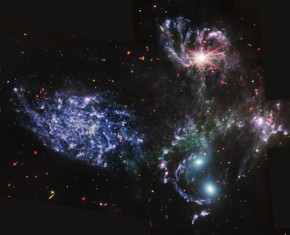The views expressed in our content reflect individual perspectives and do not represent the authoritative views of the Baha'i Faith.
Plato may have had it right all along—he saw all created things as reflections of idealized forms.
In the previous essay in this series, we discussed how religious terms such as “spirit” and “Word of God” might have corollaries to concepts in modern physics. In this final essay, we will explore more challenging terms such as “eternal soul” and “God,” and see how the seeds of these concepts might also be present in science.
Both the modern scientific idea that fundamental matter is a product of a non-physical mathematical field; and that information can be an organizing and creative agent; find common root in the ancient Platonic ideas of idealized forms as the true reality. In a previous article I discussed the relationship between Plato’s ideas and these concepts of modern physics. Contemporary scientific thought understands that the physical forms expressed in our universe are as eternally recurring and deathless as the number 3 or π.
It is a short leap to realize that consciousness itself is at the very least a product of these mathematical relationships (if not much more), and as such is similarly eternally recurring and deathless. The Baha’i concept of an eternal soul could be understood in this context:
Some hold that the body is the substance and that it subsists by itself, and that the spirit is an accident which subsists through the substance of the body. The truth, however, is that the rational soul is the substance through which the body subsists. If the accident—the body—is destroyed, the substance—the spirit—remains. – Abdu’l-Baha, Some Answered Questions, newly revised edition, p. 276.
Interestingly, the rise of information technology has exposed the primacy of relational information over matter in a very direct way. In my opinion it underlies current popular ideas of the simulation hypothesis—the idea that all of reality, including the Earth and the universe, is in fact an artificial simulation. It becomes obvious that if our perception of the physical reality is so flimsy that it can be replicated across physical platforms, perhaps this betrays a profound mistake in what is the true “base-reality” of existence. The commonly assumed idea is that existence is physical; when in fact a proper understanding of base-reality reveals that it is instead a kind of relational information.
The word ‘God’ is packed with even more baggage. The standard monotheistic definition describes an all powerful and benevolent Creator. However when this definition is examined carefully it fails, due to simple logical and mathematical consistency.
In fact mature consideration of the question of a singular and ultimate deity brings one to realize that such an entity cannot be contained by definitions. In the words of Baha’u’llah, the prophet and founder of the Baha’i Faith, God is “… sanctified above all attributes and holy above all names.” – The Most Holy Book, p. 95.
At best the word “God” can only serve as a pointer towards the infinite, the “unknowable essence,” which at the very least functions as the source of all the math and primary information and order which underlies the operation of the universe. While the secular minded might choose to leave such an idea un-named, a religious individual calls this pointer God.
In many ways, modern science should in fact be very comfortable with the concept of an eternal soul or consciousness, and with the primacy of the abstract field or spirit and order-generating information or “words of God.”
The break between the spiritually-minded and the secular on these terms would typically be on the word “God,” and consists in levels of abstraction below its primary meaning. The question is, has this ultimate reality ever manifested or communicated in some manner with humans?
On one level, based on our definitions the “Word of God” as “creative information,” the mere existence of our consciousness is sufficient proof of this—since it represents the very embodiment of creative information. As far as we know, human consciousness is the highest expression of creative information we have encountered. Humans become on some level definitional for what is knowable about God. This returns us to the ancient idea of man made “in the image of God” and inverts it, so humans represent the current limit of what is possible to know about God.
In the Baha’i writings, Baha’u’llah takes this idea even further, teaching that among humans there exist rare beings who express a supreme type of consciousness. These individuals are known as prophets or manifestations of God, and include messengers like Moses, Jesus, Muhammad, Buddha, Krishna and Baha’u’llah. Elaborating on the essential purpose of our existence and the relationship to these beings, Baha’u’llah explains:
The purpose of God in creating man hath been, and will ever be, to enable him to know his Creator and to attain His Presence. To this most excellent aim, this supreme objective, all the heavenly Books and the divinely-revealed and weighty Scriptures unequivocally bear witness. Whoso hath recognized the Day Spring of Divine guidance and entered His holy court hath drawn nigh unto God and attained His Presence, a Presence which is the real Paradise, and of which the loftiest mansions of heaven are but a symbol. – Baha’u’llah, Gleanings from the Writings of Baha’u’llah, p. 70.
















Comments
Sign in or create an account
Continue with Googleor